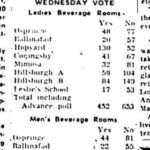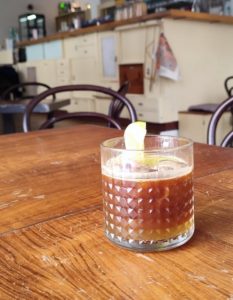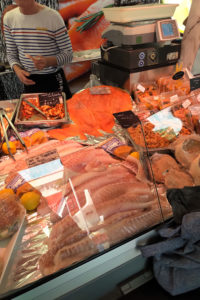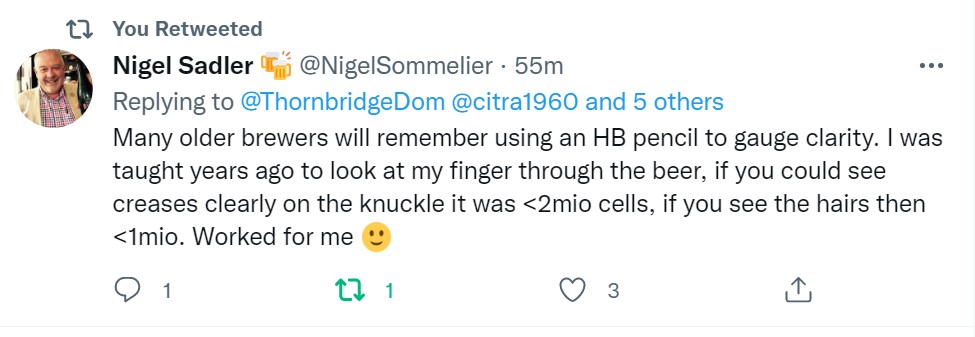 What is up?!? Happy end of July! No one ever says that. I saw back to school ads this week. That sucked. Except the kid will be going back to school. And we had some wicked storms come through this week – a tornado even hit north of here – and now it’s almost sweater weather. Nice. Portents of autumn. Already. That sorta sucks. Like the Red Sox collapsing back to .500 after being ten games up. Also sucks. Thank God for my surrogate Expos, the Mets. And they showed good taste this week by having everyone’s favourite milliners’ client, ex cool band roadie and friend of this blog, Garrett Oliver, through out a first pitch! What a great thing to have experienced.
What is up?!? Happy end of July! No one ever says that. I saw back to school ads this week. That sucked. Except the kid will be going back to school. And we had some wicked storms come through this week – a tornado even hit north of here – and now it’s almost sweater weather. Nice. Portents of autumn. Already. That sorta sucks. Like the Red Sox collapsing back to .500 after being ten games up. Also sucks. Thank God for my surrogate Expos, the Mets. And they showed good taste this week by having everyone’s favourite milliners’ client, ex cool band roadie and friend of this blog, Garrett Oliver, through out a first pitch! What a great thing to have experienced.
First news this week? Just a couple of weeks ago I mentioned the archeological digs at Sedgeford, England where medieval maltings are being uncovered. This week, beer person extraordinaire Nigel Sadler took his interest to the next level and has been participating in the dig, presumably as a volunteer. His Tweet-fest has been fabulous, including these two with their detailed observations:
The kilns are wattle and daub construction across the site. There is only evidence of one steep shown here. Likely this was used almost permanently despite the various kilns burning and being destroyed. I’m getting steep measurements later. Bags of grain were lowered in to soak… A post hole has been discovered under the germination floor sited between Kiln 1 and the steep which raises questions as to whether an earlier kiln structure was here.
Locally, one of the best small breweries in Ontario, Stone City right here in my home town, is up for sale very much as a going proposition.* Oh, to be 25 year younger and a bit wealthier.
Perhaps 25 younger and indubitably a bit wealthier in the ways of the world, The Beer Nut shared a “return to fests” story this week and included a few interesting observations about the format:
Three years after the inaugural event, Fidelity was back in the Round Room of the Mansion House a couple of weeks ago. It’s the only festival of its kind in Ireland, where punters pay up front and have free run of forty producers’ stands, each pouring two beers (with a handful of ciders and meads) per session. In a change to the previous iteration it was split across two days rather than having a daytime and evening session — I guess they get more people going to both that way. One for me was plenty and I rocked up on the Friday.
My experience of these beer buffets is that they are a bit of a disaster, encouraging bulk bevvying akin to the 1870s and 1960s here in Ontario. He also shared a follow up post on the same event and shared the best sort of takeaway anyone could hope for: “I’m sure a lot of effort goes into making sure it looks so effortless.”
 Oh, and about that bulk bevvying… I wrote another post this week myself, on Ontario’s mid-1900s attempt to provide a reasonably safe environment for beer drinkers of both genders:
Oh, and about that bulk bevvying… I wrote another post this week myself, on Ontario’s mid-1900s attempt to provide a reasonably safe environment for beer drinkers of both genders:
Those of you alive to the information era we live in will know that a year or so ago I reposted a bit of research I did for our book Ontario Beer on licensing in this here province after temperance and the phenomenon of the ladies only license that was introduced in 1934 as part of that. But I had not really considered the other side of the coin, the men’s only license.
I popped into work on Wednesday, too, and got the image up there of goold old Forms 8, 9 and 10 attached to Ont. Reg. 407 as set out in the R.R.O. 1960 which illustrates the gender based licenses. Click and gawk to your heart’s delight. I would love to find a description of a women’s only public house.
Why is the same beer book being published over and over?
Harvest time. Excellent! And another Goldthorpe sighting and at possible brewing scale. So exciting. I had thought that the grain would have migrated east. I had heard it might be around in central Asia but are there patches still in Ireland as there were in the late 1800s as this report at the time mentioned?
The next broad-eared variety is Goldthorpe, which was found in a field of Chevallier so recently as 1889. How it arose, or whether it has any connection with the Continental broad-eared forms, I cannot say. Goldthorpe has a high grain-yielding potentiality, but it is characterized by a long ” neck.” and the ears are extremely liable to become detached from the straw, especially when the crop is allowed to become fully ripe, as it should be, to obtain the highest quality. The unfortunate bearing of this characteristic on the fortune of the variety will be appreciate; when I add that Goldthorpe was, and still is, one of the best quality barleys in existence.
Broad-eared certainly sounds like Battledore.
Someone who used to post a news update every Monday sent me the link to this post about the problems – for some – associated with IPA domination… not to mention hegemony illustrated succinctly thusly:
…think back to recent years, and the kinds of beers you may have sampled from Sierra Nevada in that time. Perhaps you loved the Nooner pilsner, or the seasonal Summerfest lager. Maybe you were a devotee of the annual Oktoberfest lager, even after the COVID-19 pandemic prevented it from being a yearly collaboration with a German brewery. Maybe your jam was the Otra Vez gose, or Ruthless Rye, or fall seasonal brown ale Tumbler, or Sierraveza Mexican lager. Maybe your first exposure to classic Belgian ales was Sierra’s Ovila series of abbey ales? Not a single one of those brands is referenced anywhere on the Sierra Nevada website today. Zero of them, in any capacity, are implied to still exist.
That’s not good. And it’s boring. Keep good beer boring, IPA. Way to go. Alistair is fighting the good fight against IPA tedium with his tenth(!) annual best beers of Virginia. Recommendations include an alt, a stout, a Rauch Märzen plus a few pils/pilsens.
Perhaps conversely, the Pubmeister wrote about Margate, a favourite of mine 350 years or so ago, and covered the face paced romance of a pub game I had not heard of before – carrom:
It’s like a table top type of pool, played with fingers, our new friend demonstrating a drag that would have had him drummed out of the German Subbuteo Championships before his bare feet could touch the ground. At Xylo we met two guys out celebrating a birthday who joined the carrom enthusiasts, and Vieve and Jess, two impressive young women who reappeared a little later in the Little Swift and joined us in the sort of free-ranging conversation that you only get in pubs.
Top headline news of the week: “Beer-drinking pony who lives in pub is made mayor“! Tweet of the week? Photos and descriptions from Kitsault, a ghost town in British Columbia… but a ghost town not from the 1890s but from the 1980s that has been perfectly maintained:
In Kitsault’s community centre sits the Maple Leaf Pub. Lined with the crests of every province, it could be the pub of any small town in Canada. On the last night of the town’s existence, the remaining residents had a drink and signed a poster.
And finally… a couple of dishonourable mentions to finish up. First, I think this is one of the unkindest stunts I have ever seen – one’ arsehole’s attempt to trigger complaints about a Sam Smith’s pub. Don’t be like this:
As I went over to the bar, I pretended to search my pockets, and said “s***, I haven’t got any cash”. I asked if they took card or if a PayPal payment would be acceptable. The barmaid, who looked like a teenager, wrinkled her brow as she noticed the workspace I had created behind me. She said: “You can’t use those in here. If the owner Humphrey [Smith] were to come in and saw that, he’d tell us to shut and ask everyone to leave.” The barmaid did actually look genuinely worried. It felt as if she was being sincere. I asked her if I had to leave with my items, she said yes, that I had to go. As I was packing up, I decided to take one more selfie, to see what would happen.
Perhaps speaking of which, there is another class of arsehole that is unbearable – the “craft insider”** – the interview of one of whom, in a late sighting, illustrated the condition:
The people who care will be in the liminal space of barely knowing much about craft beer but who are usually very vocal about it.
Nice to know how folk think of others. And the superfluous abuse of “liminal” is also one of those benchmark for this sort of thing. Don’t be like that either.
That’s it for now. Long weekend coming up starting with my fourth Covid-19 shot at 4 pm Friday. Pray to the gods of your choice on my behalf. See you next week when I will complain complain complain about whatever happens. In the meantime, for more, check out the updates from Boak and Bailey mostly every Saturday but not from Stan every Monday as he is on his summer holiday. Check out the weekly Beer Ladies Podcast, and the mostly weekly OCBG Podcast on Tuesday (Ed.: some crackle this week at about 20 mins.) and sometimes on a Friday posts at The Fizz as well. There is a monthly sort of round up at The Glass (Ed.: that seems to be dead now.) There is more from DaftAboutCraft‘s podcast, too. And the Beervana podcast. And sign up for Katie’s (Ed.: now very) irregular newsletter, The Gulp, too. And check out the Atlantic Canada Beer Blog‘s weekly roundup. Plus follow the venerable Full Pint podcast. And Fermentation Radio with Emma Inch. The AfroBeerChick podcast as well! And also look at Brewsround and Cabin Fever. And Ben has his own podcast, Beer and Badword (Ed.: …notice of revival of which has been given… still not on the radio dial…) And remember BeerEdge, too, and The Moon Under Water. There has also been the Beer O’clock Show but that’s wound up now after ten years.
*Had to be told of this opportunity by the folks to the west end of the lake. Jeesh.
**Sometimes related to the “little did I know that Icelanders are mad for hotdogs” sort of expert… though, to be fair, this is an excellent confessional of a number of sins of omission. The “orange slice in wit” thing is old enough now that it is pretty hitting its own drinking age.









